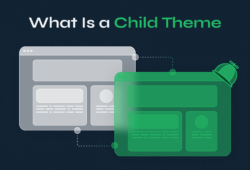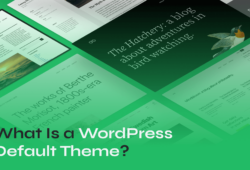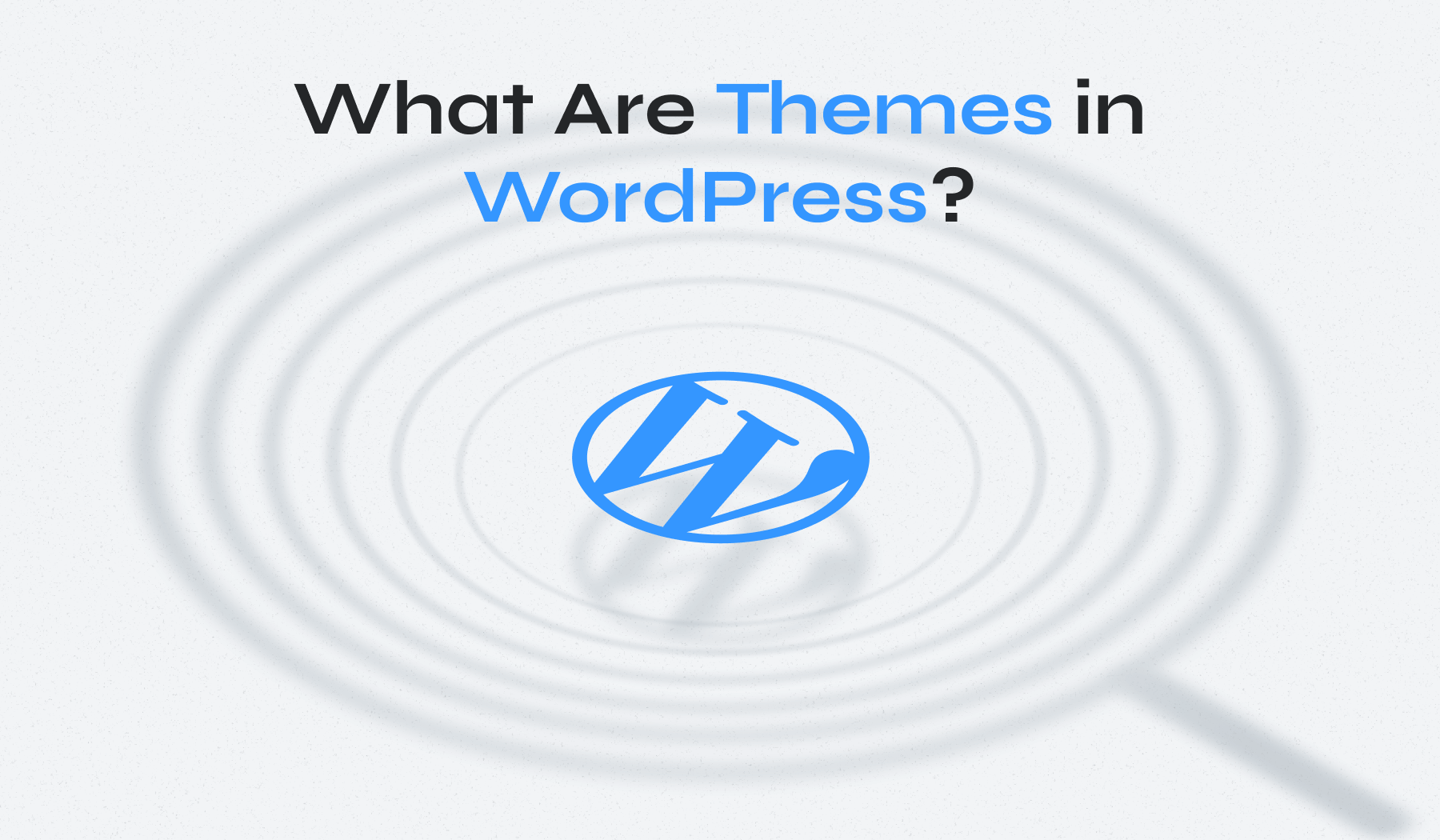
A WordPress theme is the backbone of your website’s appearance and functionality. It consists of a collection of templates and stylesheets that define how your site looks and operates. Whether you’re building a blog, an e-commerce platform, or a portfolio, selecting the right theme is vital.
This comprehensive guide will explore the details of a WordPress theme, including its components, various types, and how to choose one that aligns with your goals.
Table of Contents
- What Is a WordPress Theme?
- Types of WordPress Themes
- Do I Need a WordPress Theme?
- How to Choose the Right WordPress Theme
- How to Use WordPress Themes?
- Where to Find Good WordPress Themes
What Is a WordPress Theme?
A WordPress theme is a collection of templates and stylesheets that define the appearance and display of your WordPress website. It controls the design, layout, and overall aesthetics, dictating how your site looks and behaves for users. Essentially, a theme is the backbone of your website’s visual identity and user experience.
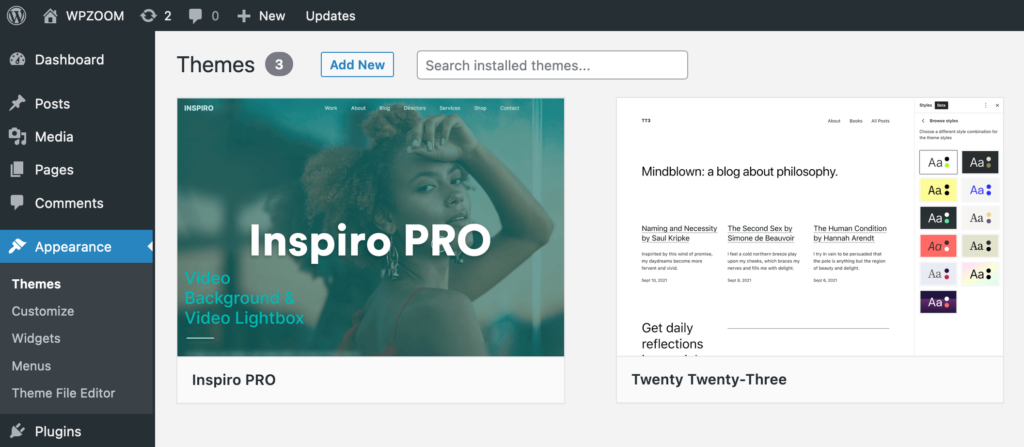
When you activate a theme on your WordPress site, it applies a unified design and layout defined by its files, which include PHP, HTML, CSS, JS, and images. For instance, if your theme’s style.css file specifies that all headings should be blue, then all the headings on your site will be displayed in blue.
WordPress determines which template file to use based on the type of page the visitor is viewing. For example, if a user is looking at a single blog post, WordPress will use the single.php file from your theme to display that page. This dynamic approach allows for a highly customizable and flexible website structure.
Most themes come with built-in options that let you modify parts of the design without touching any code. These changes can include adjusting colors, setting a background image, or choosing where menus appear. These modifications can be made directly through the WordPress Customizer or in dedicated theme settings menus available once the theme is installed.
Popular WordPress themes often come with advanced features like built-in page builders or custom post types, making it easier for users of all skill levels to create and manage their websites.
Types of WordPress Themes
Choosing the right WordPress theme can seem overwhelming given the vast array of options available. Understanding the different types of themes can help you make an informed decision that best suits your website’s needs.
WordPress themes can be categorized based on various criteria, such as cost, functionality, and intended use. In this section, we’ll explore the major types of WordPress themes, including free vs. premium, multipurpose vs. niche, and parent vs. child themes, to help you find the perfect match for your site.
Free vs. Premium Themes
When choosing a WordPress theme, one of the first decisions you’ll face is whether to opt for a free or a premium theme. Both options have their unique advantages and are suited for different purposes.
Free WordPress Themes
As the name suggests, free WordPress themes are available at no cost. You can download them from the official WordPress theme directory or from third-party sites. These themes are an excellent choice for beginners or those working with a limited budget.

Free themes offer basic features and design options, often providing a clean and simple look, which is perfect for smaller websites or blogs. Despite being free, these themes must meet strict coding standards set by WordPress, ensuring they are secure and reliable.
Premium WordPress Themes
Premium themes come with a price tag, typically ranging from $30 to $200 or more, depending on the theme and its features. These themes are usually sold by third-party companies or independent developers like WPZOOM.
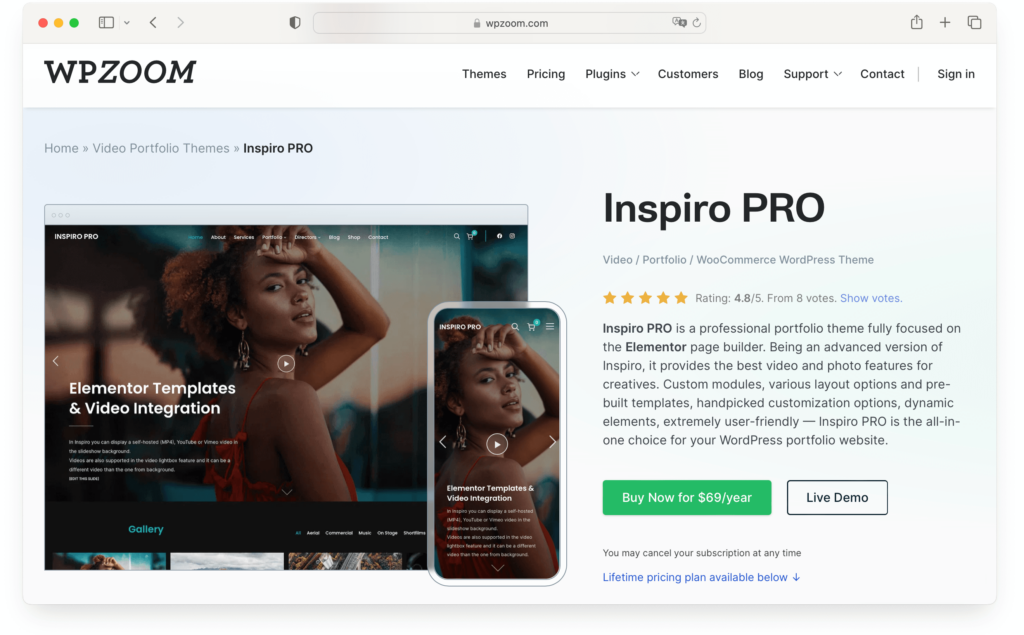
Premium themes offer a broader range of features and customization options. They often include built-in drag-and-drop builders, extensive color and font choices, and additional functionalities such as e-commerce support, portfolio layouts, and multilingual capabilities. Premium themes also usually come with regular updates and dedicated support, ensuring your site remains secure and up-to-date.
In summary, the choice between free and premium WordPress themes depends on your specific needs, budget, and the complexity of your website. Free themes are excellent for those just starting or with simpler requirements, while premium themes are better suited for users who need advanced features and dedicated support.
Multipurpose vs. Niche Themes
When selecting a WordPress theme, it’s important to consider whether a multipurpose or niche theme best fits your website’s needs. Each type offers distinct advantages and is tailored for different purposes.
Multipurpose WordPress Themes
Multipurpose themes are designed to cater to a wide range of website types. These themes are highly versatile, offering extensive customization options that allow you to create a unique website regardless of your specific requirements.
They provide numerous pre-built layouts, color schemes, font choices, and design elements, allowing you to create a site that truly reflects your vision. Additionally, these themes often come packed with advanced features such as sliders, contact forms, page builders, and more, providing all the tools you need to build a dynamic and interactive website.
However, the abundance of options in multipurpose themes can be overwhelming, particularly for beginners. The wide range of features might also slow down your website if not optimized properly, affecting performance. Moreover, due to their extensive functionality, multipurpose themes are typically more expensive, which may be a consideration if you’re working with a tight budget.
Niche WordPress Themes
Niche themes are created with a specific type of website or industry in mind. These themes are tailored to meet the unique needs and requirements of their target audience, making them an ideal choice for specialized websites.
Niche themes excel in specialization, as they are designed to fulfill the specific needs of a particular industry, such as restaurants, portfolios, or tech blogs. This focus makes them easier to set up and manage, thanks to fewer customization options that streamline the process. Additionally, niche themes are often optimized for their specific purpose, leading to better performance and an enhanced user experience, which can be crucial for certain types of websites.

On the downside, niche themes offer limited customization options, restricting your ability to alter the design and functionality outside of the theme’s intended purpose. They are less versatile, making them unsuitable for websites that need to serve multiple functions or diverse audiences. Furthermore, niche themes may include features that are only useful for specific types of websites, potentially limiting their broader application.
Your choice between multipurpose and niche themes should be guided by the specific requirements and goals of your website.
Parent vs. Child Themes
Understanding the relationship between parent and child themes is crucial for effective WordPress theme management. These themes work together to provide a robust and flexible framework for your website’s design and functionality.
Parent Themes
A parent theme is a fully functional WordPress theme that includes all the necessary files and assets required for the theme to work independently. It defines the core design and features of your website, acting as the foundation upon which child themes can build.
Parent themes offer a comprehensive set of functionalities and design elements out of the box, making them a solid choice for immediate use. They are regularly updated by developers to ensure compatibility with the latest WordPress versions and to address any security vulnerabilities. Additionally, a well-developed parent theme is designed to be extendable, allowing for customization through child themes without altering the core files.
The main drawback of using only a parent theme is that any customizations made directly to the theme’s files will be overwritten when the theme is updated. This can result in the loss of your customizations, necessitating a different approach to maintaining a personalized site.
Child Themes
A child theme inherits all the functionality, features, and style of its parent theme but allows you to make modifications without affecting the parent theme’s core files. By creating a child theme, you can add your customizations safely and ensure they are preserved during parent theme updates.
Child themes provide a safe and efficient way to customize your website. Since the child theme inherits everything from the parent theme, you can make changes to the design and functionality without altering the parent theme’s files. This separation ensures that your customizations are preserved even when the parent theme is updated. Additionally, child themes allow you to extend the parent theme’s functionality by adding custom PHP functions, styles, and templates specific to your site’s needs.
Creating a child theme requires a bit more technical knowledge compared to using a parent theme alone. You need to understand how to create and modify the necessary files to achieve your desired customizations. Additionally, if the parent theme has a major update that significantly changes its structure, you might need to update your child theme to ensure compatibility.
What Is a Default Theme?
A default theme is the pre-installed theme that comes with every new installation of WordPress. These themes are designed by the WordPress team to showcase the latest features and best practices in web design and development. Default themes provide a user-friendly starting point for building a WordPress website, making it easier for users to begin their site creation journey.
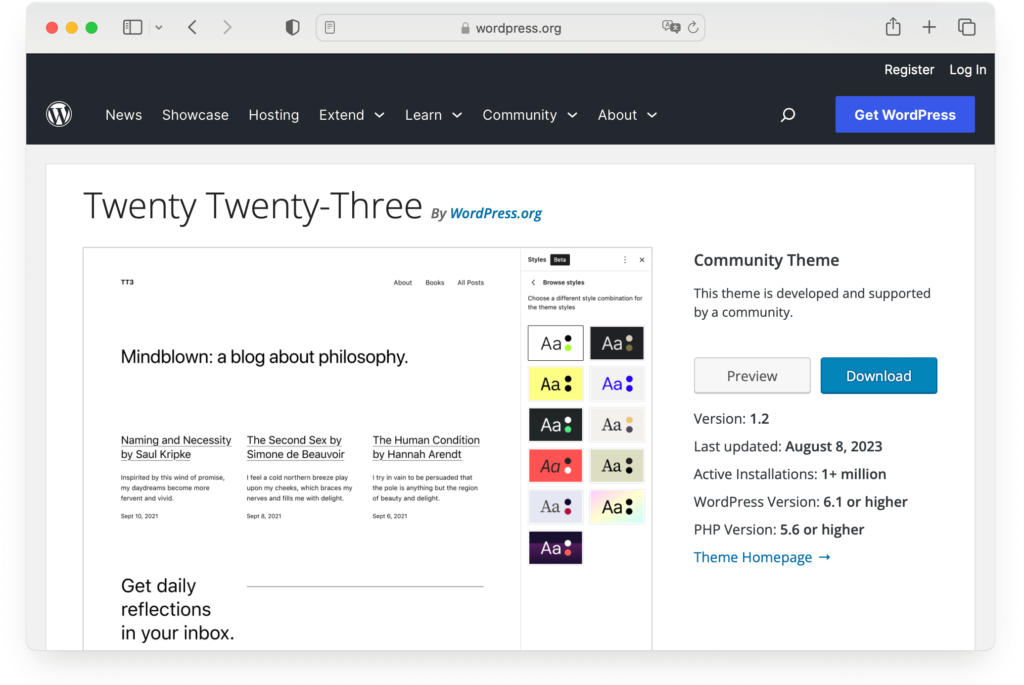
Each year, WordPress releases a new default theme, often named after the year of its release (e.g., Twenty Twenty-One). These themes are crafted to be versatile and adaptable, allowing users to customize them to fit various types of websites, from blogs to business sites.
In case something goes wrong with a custom theme, default themes serve as a reliable fallback option. Simply activating the default theme can help restore your website’s functionality.
While default themes offer some customization options, they may not provide the level of flexibility and unique design features available in premium or custom themes. Also, since many WordPress users start with default themes, your website might look similar to others if you don’t invest in customization.
What Are Custom Themes?
Custom themes in WordPress are tailor-made themes designed to meet the specific needs and preferences of an individual website. Unlike standard or default themes, which come pre-defined and can be used by multiple websites, custom themes are unique creations, often developed by professional designers or developers to offer a bespoke design and functionality.
Custom themes offer several advantages for WordPress users. They provide a unique design that reflects your brand, ensuring your website stands out. Custom themes allow for specific functionalities tailored to your business needs, such as unique booking systems or specialized navigation. They are often optimized for performance, resulting in faster load times and smoother user experiences. Enhanced security and SEO benefits are also significant, as custom themes can be built with advanced security measures and SEO best practices in mind.
However, custom themes come with drawbacks. They are typically more expensive due to the time and expertise required for development. The process takes longer compared to setting up a pre-built theme, involving detailed planning, design, coding, and testing. Maintenance might require ongoing developer support, especially with WordPress updates, incurring additional costs and dependency on the developer’s availability.
Do I Need a WordPress Theme?
If you’re planning to create a website using WordPress, the answer is a resounding yes—you absolutely need a WordPress theme. A theme is essential because it dictates the visual appearance and layout of your site, ensuring it is both functional and aesthetically pleasing. Without a theme, your WordPress site would lack structure, style, and coherence, making it difficult for visitors to navigate and engage with your content.
While themes are indispensable for most users, another option is to use a page builder plugin. Page builders like Elementor or Beaver Builder allow you to design and customize your site with drag-and-drop simplicity, offering even more control over the look and functionality. However, these plugins still work best when paired with a theme, providing a solid foundation upon which to build.
How to Choose the Right WordPress Theme
With countless WordPress themes available, selecting the perfect one for your website can be a daunting task. Here are some key factors to consider to ensure you choose a theme that fits your needs and helps you create a professional and effective site.
- Define Your Site’s Purpose and Features. Before you start browsing themes, clearly define your website’s purpose and the features you need. Are you building a blog, an e-commerce site, a portfolio, or a business website? Each type of site has different requirements. For instance, an e-commerce site will need product display and shopping cart functionalities, while a portfolio site might require gallery features to showcase your work.
- Look for Responsiveness. In today’s mobile-centric world, it’s crucial that your site looks great on all devices. Ensure the theme you choose is responsive, meaning it automatically adjusts its layout to fit screens of all sizes, from desktops to smartphones. A responsive theme provides a seamless user experience, no matter what device your visitors are using.
- Prioritize SEO-Friendly Themes. To attract organic traffic, your website needs to be optimized for search engines. Choose a theme that follows SEO best practices, with clean code, fast loading times, and proper HTML markup. An SEO-friendly theme will help your site rank higher in search engine results, making it easier for potential visitors to find you.
- Ensure Plugin Compatibility. Plugins extend the functionality of your WordPress site, so it’s important to choose a theme that is compatible with essential plugins. Compatibility with plugins ensures that you can add the features you need without any issues.
- Look for Regular Updates and Support. A good theme is regularly updated to stay compatible with the latest WordPress version and to patch any security vulnerabilities. Opt for a theme from a reputable developer who offers regular updates and reliable support. This way, you can avoid potential security risks and compatibility problems.
- Check Reviews and Ratings. Reviews and ratings from other users can provide valuable insights into the quality and reliability of a theme. Look for themes with high ratings and positive feedback. Pay attention to comments about ease of use, customization options, and customer support to ensure you’re making an informed decision.
- Consider Your Budget. While free themes can be great for those just starting out, premium themes often offer more features, better customization options, and dedicated support. Determine your budget and decide whether investing in a premium theme is worth it for your site’s needs.
- Test the Theme’s Demo. Most themes offer a live demo or preview. Take advantage of this feature to see how the theme looks and functions in action. Test different pages, navigate through menus, and explore customization options. This hands-on experience will help you determine if the theme meets your expectations and is user-friendly.
Discover more in our guide on How to Choose a WordPress Theme.
How to Use WordPress Themes?
Using WordPress themes can significantly enhance your website’s appearance and functionality. Here’s a general guide on how to effectively install, customize, update, change, and uninstall WordPress themes to make the most of your website.
Installing a WordPress Theme
Installing a WordPress theme is a simple process. You can browse thousands of free themes directly from your WordPress dashboard under the Appearance > Themes section. To install a new theme, click on the Add New button, search for a theme, and click Install followed by Activate. For premium themes purchased from third-party vendors, you can upload the theme’s zip file through the same interface.
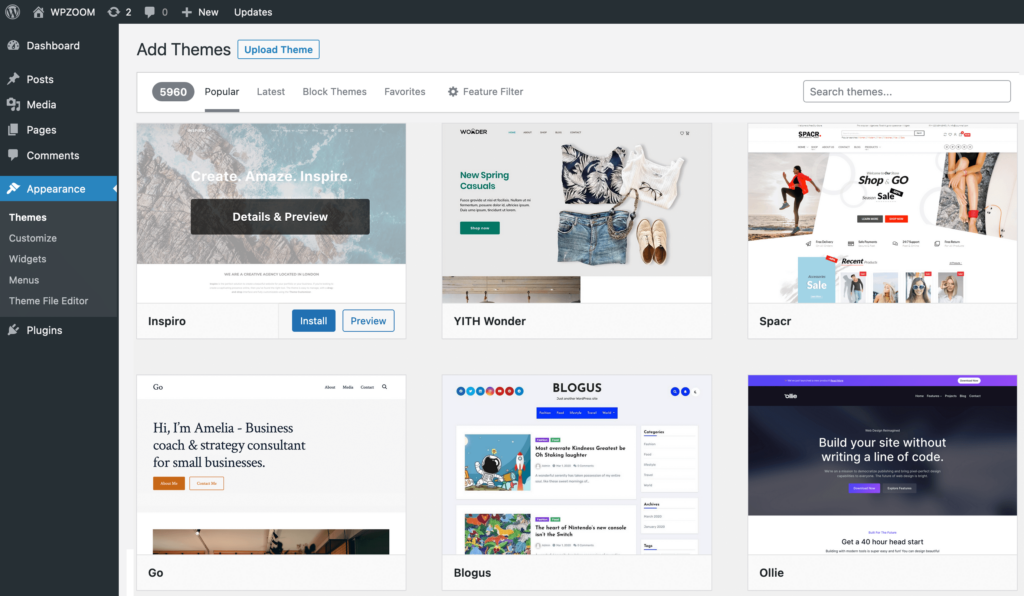
Further reading: How to install a WordPress theme.
Customizing a WordPress Theme
Once you have installed and activated a theme, the next step is customization.
Most themes come with a variety of customization options that allow you to personalize the design to fit your brand. You can access these options through the WordPress Customizer, found under Appearance > Customize. Here, you can modify elements such as colors, fonts, layouts, and more.
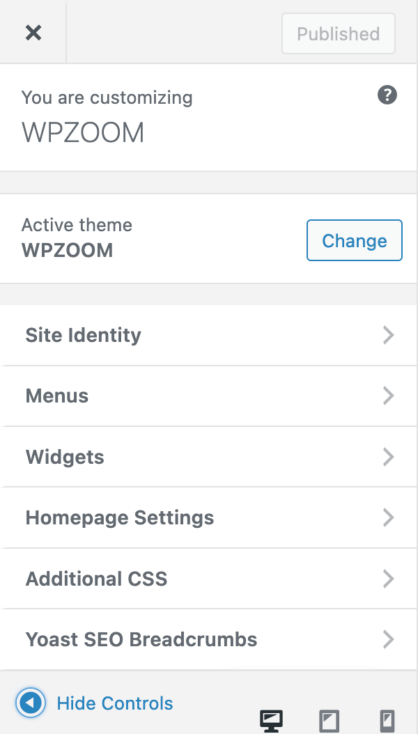
Many premium themes offer additional customization panels or built-in page builders that provide even greater flexibility and control over your site’s design.
Further reading: How to customize a WordPress theme.
Updating Your Theme
Keeping your theme up to date is crucial for security and compatibility reasons. Updates often include new features, bug fixes, and security patches.
WordPress will notify you when updates are available, and you can update your theme directly from the dashboard under Appearance > Themes. It’s recommended to back up your site before performing updates to ensure you can restore it if anything goes wrong.
Further reading: How to update a WordPress theme.
Changing a WordPress Theme
If you ever need to change your theme, WordPress makes it easy to switch without losing your content.
Navigate to Appearance > Themes, select the new theme you want to activate, and click Activate.
Be sure to preview the new theme and make any necessary adjustments to widgets, menus, and settings to ensure a smooth transition. Test your site thoroughly to ensure all functionalities work as expected after the change.
Uninstalling a WordPress Theme
Uninstalling unused themes can help keep your WordPress installation clean and secure.
To uninstall a theme, first ensure it’s not the active theme. Then, go to Appearance > Themes, click on the theme you want to remove, and select Delete.
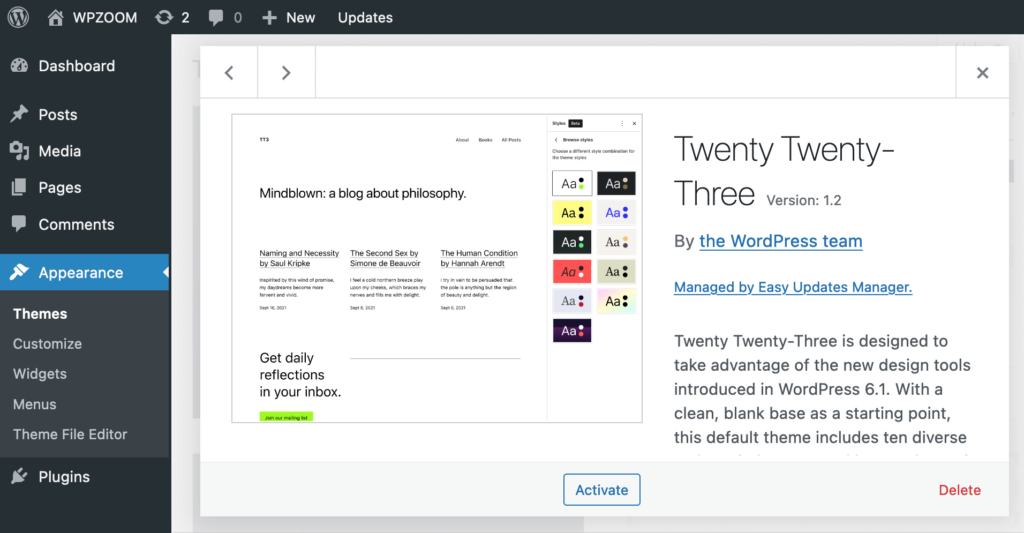
This helps free up server space and reduces potential security vulnerabilities.
Further reading: How to delete themes in WordPress.
Where to Find Good WordPress Themes
WPZOOM is the result of years of passion and dedication for WordPress solutions. Our mission has always been to provide you with the best themes and plugins for your website and business.

We offer a wide range of premium WordPress themes, with countless possibilities for blogs, businesses, portfolio sites, or magazines. The themes we offer are curated, well-designed, optimized for mobile and desktop use, and follow the best SEO practices.
